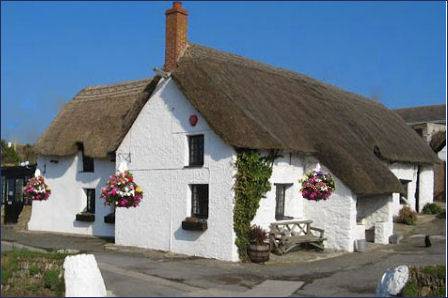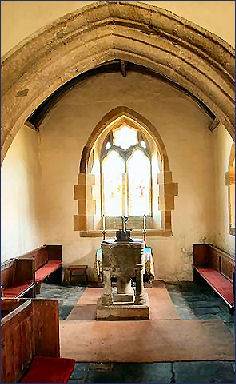Cubert
OS grid reference - SW785579
 The village of Cubert is located three miles south-southwest of Newquay.
The village of Cubert is located three miles south-southwest of Newquay.
Known in Cornish as Egloskubert, the village is is named after the Welsh missionary St Cubert who, as a companion of St Carantoc, brought the Christian faith to this part of Cornwall. Unlike his companion St Carantoc, who travelled on to Brittany, St Cubert returned to Wales becoming abbot of his monastery and, according to the Welsh chronicles, died in 775.
The village of has been without its prefix 'St' since the sixteenth /seventeenth century when it was abandoned at the same time as the churchwardens whitewashed over the figure of St Cubert dressed as an abbot on the inside wall of the church. On early maps it often appears as St Kibberd.
The village pub, the Treguth Tavern (pictured above left) dates back to the the late thirteenth century and began life as a farmstead known as Tregyeu. survived as a farmstead all the way until the turn of the 20th Century with the advent of tourism to the area. At around 1920, the farm became "Oates Tea House," and remained a Tea House until 1962, when "The Treguth Inn" was born as the public house.
A medieval Holy Well dedicated to St Cubert lies the west of the village, half way between the village and the coast, from which Holywell Bay derives its name. The well is accessed via two ornate arched doorways revealing stone seats.
A futher well is situated to the north end north end of Holywell beach, which only accessible two hours before and after low-tide
The Church of St. Cubert
 The village is dominated by the spire of its medieval church which dates back to the fourteenth century, the building was enlarged by the addition of a south aisle a century later. The first church to occupy this site would probably have been a small simple wooden building with a thatched roof.
The village is dominated by the spire of its medieval church which dates back to the fourteenth century, the building was enlarged by the addition of a south aisle a century later. The first church to occupy this site would probably have been a small simple wooden building with a thatched roof.
The royal coat of arms of King George IV is displayed on the wall which shows the arms of the House of Hanover. The stone font is possibly the oldest item in the church, it is almost certainly late Norman and came from the second church to occupy the site, built soon after the Norman conquest of the eleventh century.
Through the arch way into the South transept, a recess for a tomb, some eight feet wide, it is situated beneath the window. This is thought by some to have been the position where the relics of St. Cubert were once placed.
Following the saint's death, it is related that his relics were returned to Cornwall. In the fifteenth century the relics of St Cubert along with those of his companion, St Carantoc and the bones of St Piran and St Lewlyna and were carried on certain Sundays of the year to a chapel that stood near to the cross roads where the main Newquay road and road to St Cubert and St Newlyn East come together.